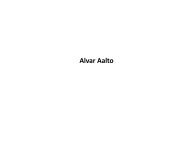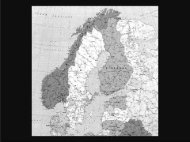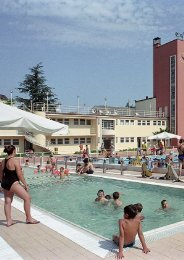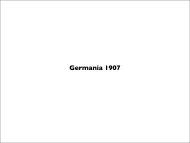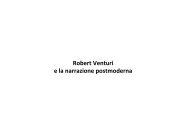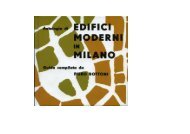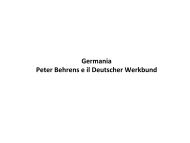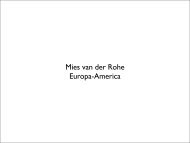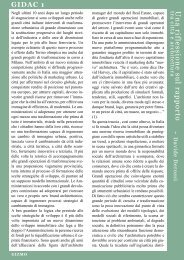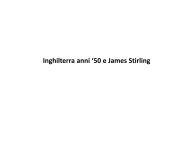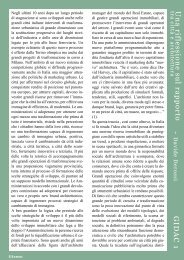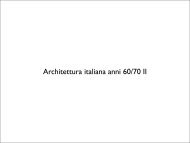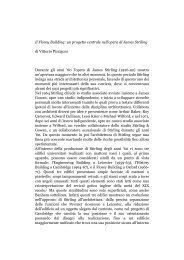DOGMA (Pier Vittorio Aureli, Martino Tattara) Stop City ... - GizmoWeb
DOGMA (Pier Vittorio Aureli, Martino Tattara) Stop City ... - GizmoWeb
DOGMA (Pier Vittorio Aureli, Martino Tattara) Stop City ... - GizmoWeb
You also want an ePaper? Increase the reach of your titles
YUMPU automatically turns print PDFs into web optimized ePapers that Google loves.
<strong>DOGMA</strong> (<strong>Pier</strong> <strong>Vittorio</strong> <strong>Aureli</strong>, <strong>Martino</strong> <strong>Tattara</strong>)<br />
<strong>Stop</strong> <strong>City</strong><br />
1.<br />
In a provoking text written few years ago, the Italian philosopher Paolo Virno 1<br />
described contemporary fascism as the new ways in which economic power seizes<br />
and orchestrates the totality of subjectivities in order to reproduces itself – as having<br />
disregarded its prior image of “top down” power, and having instead taken the<br />
kaleidoscopic forms and sense of existential instability of metropolitan life. Virno<br />
describes contemporary fascism as the “twin brother” of the most radical instances of<br />
social newness that emerged within the crisis of modern forms of labour, namely<br />
Fordist modes of production. Fascism today takes the form of informal social<br />
behaviours that escape intelligible forms of political life. In Europe economic power<br />
extends its possibilities of management and reproduction within the most progressive<br />
forms of “bottom-up” creativity, participation and informality. It is by understanding<br />
the deeply political nature of this social context and the way that flexibility has<br />
become the most powerful way of mastering the city and its conflicts, that we may be<br />
able of explain the critical fortune of a concept such as informal urbanism. In this<br />
concept lies a mystifying rhetoric of power whose main ideological goal today is to<br />
render capitalism’s uneven geography of redistribution—its systematic de-regulation<br />
and laissez-faire policies— as the natural, “spontaneous” and thus acceptable<br />
evolution of the city.<br />
As a critique of such rhetoric, and especially of the way it has been represented by<br />
architects and urban designers within the recent avalanche of so called “bottom-up”<br />
strategies for the “informal city”, we re-invest the architectural project with its<br />
(proper) mission: to establish a principle of order through which to frame and<br />
construct forms of inhabitation. Yet we understand the project of the city, not as the<br />
ubiquitous design and the managing of its inhabitation, but as the rethinking a<br />
controversial topic that in recent years has become a taboo: the definition of the form<br />
of the city. In the project that we present we understand the problem of city form not<br />
1 Paolo Virno, “Theses on the New European Fascism”, Greyroom 21 (2005), pp. 21-25.
only in terms of its morphological appearance, but also within the broader formal and<br />
political concept of form, that is the concept of limit.<br />
Practicing the limit through the production of an architectural project acquires two<br />
levels of meaning: it first refers to the physical space of the limit, namely establishing<br />
constraints and processes of stoppage to the endless growth of the city; and, secondly,<br />
in more conceptual terms, it refers to the idea that architecture should turn its back to<br />
the drama of newness and define with conceptual clarity and formal exemplarity the<br />
prototypical forms of density: living and working spaces that would counter the lifestyle<br />
of individualism and laissez-fare propelled by neo-liberal urban policies.<br />
The richness and multiplicity of meanings of the concept of limit finds its origin in the<br />
ambivalence of the simple act of marking a limit. If on the one the concept of limit<br />
represents the beginning of every human settlement, it is also – as Carl Schmitt<br />
affirmed in his seminal work on the “jus publicum Eeropaeum”, the starting point of<br />
the formation of any form of jurisdiction. Marking the land, tracing the limit are not<br />
only the primordial forms of establishing the settlement form, but their consequences<br />
reach the possibility of the coexistence of people, and power formations of every sort<br />
which are always “founded on new spatial divisions, new enclosures, and new spatial<br />
orders of the earth”. 2<br />
We have decided to address the possibility of the project of the limit of the city by<br />
means of our own tools: with drawings and with words. The proposal that we present<br />
here is an ongoing research for a city model called <strong>Stop</strong> <strong>City</strong>.<br />
2.<br />
<strong>Stop</strong> <strong>City</strong> is the hypothesis for a non-figurative architectural language for the city. By<br />
assuming the form of the border that separates urbanization from empty space, <strong>Stop</strong><br />
<strong>City</strong> is proposed as the absolute limit, and thus, as the very form of the city. <strong>Stop</strong> <strong>City</strong><br />
develops vertically. <strong>Stop</strong> <strong>City</strong> is an archipelago of islands of high density. The growth<br />
of <strong>Stop</strong> <strong>City</strong> happens by virtue of its limit, i.e. by the punctual repetition of the basic<br />
unit, which is a city of 500.000 inhabitants made of eight slabs measuring 500 by 500<br />
2 Carl Schmitt, The Nomos of the Earth in the International Law of Jus Publicum Europaeum (New<br />
York: Telos Press Publishing, 2003), p. 79.
meters, 25 meters thick. These eight slabs are positioned on the border of a square<br />
with side length of 3 kilometres, thus demarcating an “empty” area. Each slab is a<br />
“city within the city”, an Immeuble Cité that is in itself a self-sufficient city not<br />
characterized by any specific program or activity, being the support of multiple<br />
programs or activities.<br />
Given the extreme height of each immeuble cité and the overall density of inhabitants,<br />
mobility acquires the complexity a traditional city. Several means of vertical and<br />
horizontal transportation at different speeds are deployed to allow for convenient<br />
movements between the city parts (floors) and among the immeuble cité. Similar to<br />
the city, transportation becomes the device to establish hierarchies, rhythms and<br />
possibilities in the way inhabitants experience urban space. The immeuble cité has no<br />
elevation: its face presents the vertical array of floor slabs with the free distribution<br />
and position of rooms in each floor. The square defined by the eight slabs positioned<br />
along its perimeter is empty, a simple urban void filled by a forest. This horizontal<br />
canopy of densely planted trees represents the limit against urbanization, and thus<br />
renders the very form of <strong>Stop</strong> <strong>City</strong>.<br />
<strong>Stop</strong> city refrain from architecture; it is a model of a city in which there is no<br />
architecture as traditionally intended, but only the attempt to architecturally frame the<br />
city.<br />
Our proposal pursues the idea of an ohne eigenschaften architecture – an architecture<br />
without attributes – in other words an architecture that is freed from image, from<br />
style, from the obligation to extravagance, from the useless invention of new forms.<br />
<strong>Stop</strong> <strong>City</strong> is architecture freed from itself; it is the form of the city.<br />
3.<br />
In the 1930’s at the time of the capitalism’s restructuring after the crisis of 1929,<br />
Walter Benjamin critically assessed an early form of capitalist power – the<br />
architecture of Parisian arcades—as pre-condition for class emancipation after the<br />
crisis of capitalism 3 . Writing on this Arcade Project, Susan Buck-Morss has said that<br />
"The Passagen-Werk is a historical lexicon of the capitalist origins of modernity, a<br />
3 See: Walter Benjamin Das Passagen-Werk. (Frankfurt: Gesammelte Schriften, vol. V, Suhrkamp,<br />
1991).
collection of concrete, factual images of urban experiences… [Benjamin's] method<br />
was to create from them constructions of print that had the power to awaken political<br />
consciousness among present-day readers" 4 In the same way Benjamin appropriated a<br />
pre-existing architectural form such as the urban arcades in order to critically<br />
elucidate the terms of his own’s present time capitalism, our project <strong>Stop</strong> <strong>City</strong><br />
critically (and polemically) appropriate Archizoom’s model of homogeneous<br />
urbanization - their No-<strong>Stop</strong> <strong>City</strong> (1968−72) - at the moment in which the premises to<br />
that project are no longer a (utopian) projection, but an acute and sarcastic analysis of<br />
the reality in which we live.<br />
No-stop <strong>City</strong> reduced the capitalist city to a continuous urban field meant to dissolve<br />
the built structure of the city into its constitutive infrastructural elements – column,<br />
elevator, wall, etc., by envisioning the city as a vast, artificially lit, air-conditioned<br />
interior 5 . Differences such as inside and outside, landscape and city, production and<br />
consumption, living and working, were collapsed into one equipped surface that was<br />
meant to be extendable in all directions along its underlying grid, which represented<br />
the most generic order possible. Contrary to many utopian projects of that time, Nostop<br />
<strong>City</strong> was meant to be a hyper-realistic project: The city is what it does. The city is<br />
a continuous ambiance made by repetitive conditions of light, communication, airconditioning,<br />
mechanized transportation, and all of the social connections – material<br />
and immaterial – that were needed in order to make a city works and reproduces<br />
itself. Thus No-<strong>Stop</strong> <strong>City</strong> formalized the conditions that make the city. Neither a<br />
proposal for a new city nor a utopian transformation of the existing city, No-<strong>Stop</strong> <strong>City</strong><br />
was meant to be a conceptual X-ray of the existing capitalist metropolis, in which the<br />
conditions for reproduction were no longer localized in specific sectors, such as the<br />
factory, housing, and recreation spaces, but proliferated everywhere. In this scenario,<br />
the iconoclastic form of No-<strong>Stop</strong> <strong>City</strong> can be understood as a merciless memento mori<br />
4 Susan Buck-Morss, The Dialectics of Seeing. Walter Benjamin and the Arcades Project (Cambridge,<br />
Mass. and London: MIT Press, 1991), pp. 336.<br />
5 The theses concerning what later Archizoom called No-<strong>Stop</strong> <strong>City</strong> were presented already in 1970 in<br />
the pages of Casabella with the significant title, “Città, Catena di Montaggio del Sociale” (<strong>City</strong>,<br />
assembly line of the social). The project was first published as No-<strong>Stop</strong> <strong>City</strong>: Residential Parkings,<br />
Climatic Universal System, in 1971 on the pages of the magazine “Domus”. See: Archizoom Associati,<br />
Città, Catena di Montaggio del Sociale. Ideologia e Teoria della Metropoli, Casabella n. 350-351<br />
(1970); Archizoom Associati, No-<strong>Stop</strong> <strong>City</strong>: Residential Parkings, Climatic Universal System, Domus<br />
n. 496 (1971). For a detailed description of the project see: Andrea Branzi, No-<strong>Stop</strong> <strong>City</strong> (Paris:<br />
Editions HYX, 2006), which contains English translations of the magazine texts.
for architecture as a shape-maker and producer of difference. Within the objective<br />
conditions of the metropolis, formal complexity becomes ideological and a false<br />
consciousness that pretends to explain the functioning of the city with futile formal<br />
gestures. For this reason No-stop <strong>City</strong> was not an avant-garde project, nor it was a<br />
anti-modernist project, but a hypothesis that attempted to bring to radical terms the<br />
very premises of modernity: the project for a generic city in which living is reduce to<br />
biopolitical mechanisms of production and reproduction.<br />
For this reason No-<strong>Stop</strong> <strong>City</strong> should be read as the continuation (and critical<br />
exaggeration) of the urban research tradition undertaken by planners such as Ildefonso<br />
Cerdà in the 19 th century and Ludwig Hilberseimer in the first half of 20 th century.<br />
Instead of planning the city by means of architectural figures, Cerdà established his<br />
extension of the city of Barcelona, by focusing on the bio-political management of the<br />
city, such as demographic control, infrastructure, and zoning. This strategy resulted in<br />
a “non-figurative” design of the city 6 . <strong>City</strong> form was reduced into an isotropic and<br />
thus extendable grid, which articulated the equal distribution of services and roads<br />
throughout the city area. A religious center appears in every nine-block district, a<br />
marketplace every four blocks, a park every eight, a hospital every sixteen, and the<br />
formula continues. For Cerdà the city was urbanization: the potentially limitless<br />
growth of the city by means of production and reproduction 7 . Correspondingly the<br />
action of planning of urbanization became a reformist project in which amelioration<br />
of the workers living conditions inevitably coincided with the containment of their<br />
political subjectivity. This containment was defined as the possibility of urbanization<br />
to be a continuous process of expansion of its own logic that would progressively<br />
proliferate in any aspect of life. With his city plans and theoretical writings,<br />
Hilberseimer gave an even more radical interpretation of urbanization. He asserted<br />
that the effects of capitalism on the organization of the city were reformable only by<br />
assuming, as principle of urban design, capitalism most extreme cultural conditions:<br />
uprootedness and genericity of urban space. Hilberseimer manifested these conditions<br />
in his plans for territorial settlements – from his project for a Verical <strong>City</strong> (1927) to<br />
6 Which was exposed few years later in the fundamental book Teoria General del la Urbanizacion<br />
(1867). See: Ildefonso Cerdà, General Theory of Urbanization (Electa Spain: Barcellona, 1992).<br />
7 Ildefonso Cerdà was the inventor of the term urbanization
his proposal for the American New Regional Pattern (1949) - by advancing an<br />
architectural form on the verge of its disappearance, made of generic and repeatable<br />
elements.<br />
Archizoom’s No-stop <strong>City</strong> was not simply a radical accommodation of this legacy but<br />
also its class-critique. Following the idea that the working class is strongest only at<br />
the level of its utmost level of alienation, Archizoom strategically adopted the radical<br />
reformism of Hilberseimer not as simply as amelioration, but as working-class<br />
appropriation of the urban condition. This “appropriation” consisted in the possibility<br />
for the inhabitants to be confronted not only with reform of the urban environment,<br />
but also with a straightforward and didactic architectural translation of such reform<br />
liberated from the rhetorical forms of humanitarian socialism and rendered in its<br />
literal terms of (political) framework for life.<br />
5.<br />
Almost 40 years after No-stop <strong>City</strong>, our proposal for <strong>Stop</strong> <strong>City</strong> appropriate and<br />
continues the non-figurative language developed by Cerdà, Hilberseimer and<br />
Archizoom, completely reversing their urban thesis. If Cerdà, Hilberseimer and<br />
Archizoom conceived the city as formless and limitless - as urbanization - our<br />
project, by assuming the form of a border that separates urbanization from void space<br />
proposes itself as an absolute limit, and therefore as the form itself of the city.<br />
The main thesis of <strong>Stop</strong> <strong>City</strong> stems from the observation that today the relationship<br />
between those who live and work in the city and the city itself recalls the relationship<br />
that workers use to have with the factory during the era of industrial expansion 8 . If the<br />
factory was dominated by the spatially and temporally choreographed rhythm of the<br />
assembly line, today’s cities are dominated by the pervasive informality of social<br />
relationships in which any aspect of human communication and cognition is expected<br />
to become a factor of production. In other words, the contemporary city in spite of its<br />
increasing complexities, contradictions, and informalities has become reduced to<br />
simply being the contemporary factory, and its inhabitants are (potentially) the new<br />
working class. This is evident if we consider the fact that capitalistic production has<br />
8 See: Antonio Negri, Dalla Fabbrica alla Metropoli (Roma: Datanews, 2008).
historically and radically evolved by expanding its domain from the manufacture of<br />
goods to production of services such as communication, education and cultural<br />
exchange. Production occurs not only in terms of what we traditionally understood as<br />
working activities, but tends to coincide with the whole spectrum of social activities<br />
as the ones related to culture, media, and education, and all the bio-political means of<br />
life (re)production. In this context the optimistic and harmonious representation of<br />
multiplication of identities and subjectivities that characterize the social and political<br />
landscape of post-Fordism and that sociologist, artists, and architects effortlessly map,<br />
analyze and celebrate as the triumph of diversity and of difference, represent a great<br />
mystification. Behind the superficial praise [and facile image of] for multiplicity, the<br />
mystification concerns the fact that the pervasiveness of work within the entire<br />
spectrum of social relationships implies an ethos made of increasing generic,<br />
uprootedness and abstraction with which contemporary forms of production actualize<br />
their processes within society. Urban theories and social analysis that overlook this<br />
reality produce the same kind of rhetoric rehearsed by images of the city as a site of<br />
value-free congestion, leisure, spectacle, and consumption.<br />
<strong>Stop</strong> <strong>City</strong> is a model of the city where the ubiquitous attributes of contemporary<br />
production such as generic, uprootedness, and abstraction are not rejected in the name<br />
of some humanistic good intention, but are radicalized to the extreme: they become<br />
the “political, and aesthetic surplus” of the same attributes: their legibility aims at<br />
stimulating a new class consciousness that may introduces stoppages – i.e. a limit -<br />
within the continuous space of urbanization.<br />
Our project for <strong>Stop</strong>-<strong>City</strong> maintains that to propose projects at the scale of the entire<br />
city is to address the possibility of a political subject. We maintain that political<br />
subjects are not the by-product of sociological identity: lifestyles, groups,<br />
communities, social targets, etc., but that political subjects are made of the balance of<br />
powers at stake. “Labor power” refers to the fact that anything that exists in society<br />
has to be productive and thus must be put at work, and the workers, those who find<br />
themselves shaped by this condition of work, can potentially express a subjectivity<br />
that exceeds such social, cultural, and political boundaries. This excessive subjectivity<br />
cannot be proposed through architecture, but architecture can provoke this
subjectivity to emerge and take a position. It is precisely in this framework that <strong>Stop</strong><br />
city introduces the issue of limit as its main theme. Architecture no longer as what<br />
implies growth, extension, multiplication, flexibility, but as the practice that limits<br />
such possibility. According to this logic, architecture does not become the design of<br />
everything, but becomes what releases everything from being designed.<br />
In 1970, No-<strong>Stop</strong> <strong>City</strong> prophesized total urbanisation of the city. Today, <strong>Stop</strong> <strong>City</strong><br />
suggests the beginning of a slow but inexorable comeback of the city against<br />
urbanisation. If the urban perception of liberal democracy coincides with the theoretic<br />
premises of the No-<strong>Stop</strong> <strong>City</strong>, namely diffusion, ubiquity and individualisation, the<br />
form of <strong>Stop</strong> <strong>City</strong> suggests the possibility of a new communitarian life that introduces<br />
a renewed spirit of secessionism within the smooth and totalizing spaces of<br />
urbanization. To imagine a form of communitarian life as phenomenon of separation<br />
rather than one based on universality means to imagine the limit within which each of<br />
city life is constituted.<br />
Against the taboo that form means to abdicate from a political vision of the city, <strong>Stop</strong><br />
<strong>City</strong> intends to provide a theory (in the original, non-intellectual, sense of the word<br />
vision) of political organisation and of the city through the absolute form of an<br />
architectural project.



